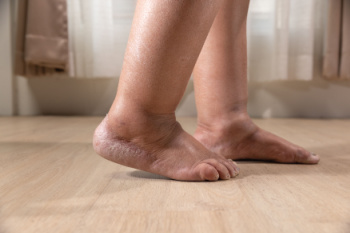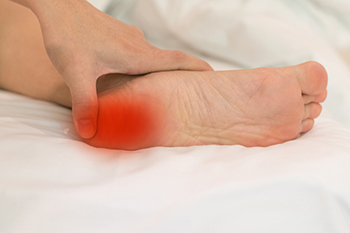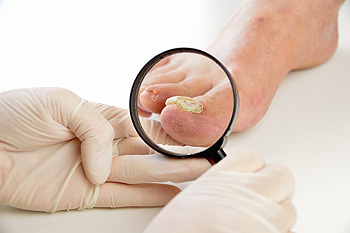Connect With Us
Blog
Items filtered by date: June 2024
Possible Causes of Swollen Feet
 Swollen feet can be uncomfortable and concerning, often signaling an underlying issue. One common cause is prolonged standing or sitting, which leads to fluid accumulation in the feet due to gravity. This is often seen in people with sedentary jobs or those who travel long distances. Another possibility is injury. Sprains, fractures, or other injuries to the foot or ankle can cause swelling as the body responds with inflammation to protect the area. This type of swelling is usually accompanied by pain and bruising. Additionally, medical conditions such as heart disease, kidney disease, or venous insufficiency can lead to swollen feet. These issues affect the body's ability to circulate and balance fluids properly, resulting in fluid retention in the lower extremities. If your feet are persistently swollen or if swelling is accompanied by other symptoms, it is suggested that you visit a podiatrist for a proper diagnosis and treatment plan as quickly as possible.
Swollen feet can be uncomfortable and concerning, often signaling an underlying issue. One common cause is prolonged standing or sitting, which leads to fluid accumulation in the feet due to gravity. This is often seen in people with sedentary jobs or those who travel long distances. Another possibility is injury. Sprains, fractures, or other injuries to the foot or ankle can cause swelling as the body responds with inflammation to protect the area. This type of swelling is usually accompanied by pain and bruising. Additionally, medical conditions such as heart disease, kidney disease, or venous insufficiency can lead to swollen feet. These issues affect the body's ability to circulate and balance fluids properly, resulting in fluid retention in the lower extremities. If your feet are persistently swollen or if swelling is accompanied by other symptoms, it is suggested that you visit a podiatrist for a proper diagnosis and treatment plan as quickly as possible.
Swollen feet can be a sign of an underlying condition. If you have any concerns, contact Howard Kimmel, DPM of Buckeye Foot Care. Our doctor can provide the care you need to keep you pain-free and on your feet.
Swollen feet are a common ailment among pregnant women and people who stand or sit for extended periods. Aging may increase the possibility of swollen feet and patients who are obese often notice when their feet are swelling too. There may be medical reasons why swollen feet occur:
- Phlebitis - A condition that causes the veins to become inflamed and can also cause leg pain.
- Liver disease - This may lead to low blood levels of albumin which is a protein. This can cause fluid in the blood to pass into the tissues and several areas of the body can become swollen.
- Heart failure - When the heart doesn’t pump properly the blood that is normally pumped back to the heart can pool in the veins of the legs causing swollen feet.
- Kidney disease - One of the main functions of the kidneys is releasing excess fluid in the body. This type of condition can make it difficult for the kidneys to function properly, and as a result the feet may become swollen.
- Deep-vein thrombosis (DVT)- This is a serious condition where blood clots form in the veins of the legs. They can block the return of blood from the legs to the heart which may cause the feet to swell. It is important to be treated by a podiatrist if this condition is present.
Swollen feet can also be caused by bone and tendon conditions, including fractures, arthritis, and tendinitis. Additionally, there may be skin and toenail conditions and an infection may cause the feet to swell. Patients who take medicine to treat high blood pressure may be prone to getting swollen feet.
Many patients elevate their feet to help relieve the swelling and this is generally a temporary remedy. When a podiatrist is consulted the reason behind the swelling can be uncovered and subsequently treated.
If you have any questions please feel free to contact one of our offices located in Brook Park and Willoughby, OH . We offer the newest diagnostic tools and technology to treat your foot and ankle needs.
Anatomy and Causes of Sever's Disease

Sever's disease, a common cause of heel pain in growing children, involves inflammation of the growth plate in the heel. This condition occurs during periods of rapid growth, typically affecting active children aged eight to 14. The growth plate, or epiphyseal plate, is an area of developing cartilage tissue at the end of long bones. In Sever's disease, repetitive stress from activities like running and jumping causes inflammation and pain in the heel. Factors such as tight calf muscles, flat feet, or high arches can worsen the condition by increasing tension on the growth plate. Understanding the anatomy of the growing heel and the mechanical stresses involved is vital for identifying and managing Sever's disease. Rest, stretching exercises, and wearing supportive footwear are effective measures to alleviate symptoms and promote healing. If your active child has heel pain, it is suggested that you contact a podiatrist who can accurately diagnose and treat Sever’s disease.
Sever's disease often occurs in children and teens. If your child is experiencing foot or ankle pain, see Howard Kimmel, DPM from Buckeye Foot Care. Our doctor can treat your child’s foot and ankle needs.
Sever’s Disease
Sever’s disease is also known as calcaneal apophysitis, which is a medical condition that causes heel pain I none or both feet. The disease is known to affect children between the ages of 8 and 14.
Sever’s disease occurs when part of the child’s heel known as the growth plate (calcaneal epiphysis) is attached to the Achilles tendon. This area can suffer injury when the muscles and tendons of the growing foot do not keep pace with bone growth. Therefore, the constant pain which one experiences at the back of the heel will make the child unable to put any weight on the heel. The child is then forced to walk on their toes.
Symptoms
Acute pain – Pain associated with Sever’s disease is usually felt in the heel when the child engages in physical activity such as walking, jumping and or running.
Highly active – Children who are very active are among the most susceptible in experiencing Sever’s disease, because of the stress and tension placed on their feet.
If you have any questions, please feel free to contact one of our offices located in Brook Park and Willoughby, OH . We offer the newest diagnostic and treatment technologies for all your foot and ankle injuries.
Managing Toenail Fungus Infections

Fungal toenail infections, or onychomycosis, account for approximately 50 percent of all nail diseases, particularly affecting toenails. Laboratory diagnosis through microscopy and culture of nail clippings is recommended before starting treatment to confirm the infection type. For patients requiring treatment of fungal toenails, oral antifungal medications are typically used for severe infections, while topical antifungals are suitable for superficial or minor cases and for those unable to take oral medications. The duration of treatment varies, with systemic medications typically requiring a few months and topical treatments possibly extending up to two years. Patients should be aware that treatment success rates vary, and nails may not return to a completely normal appearance even after successful therapy. Additionally, there is a risk of treatment failure or relapse, necessitating further diagnosis and possibly alternative treatment strategies. Ultimately, the decision to treat fungal nails should be individualized, considering the patient's overall health, risk factors such as diabetes or vascular disease, and the severity of the infection. If you have developed a fungal toenail infection, it is suggested that you schedule an appointment with a podiatrist for a diagnosis and treatment suggestions.
If left untreated, toenail fungus may spread to other toenails, skin, or even fingernails. If you suspect you have toenail fungus it is important to seek treatment right away. For more information about treatment, contact Howard Kimmel, DPM of Buckeye Foot Care. Our doctor can provide the care you need to keep you pain-free and on your feet.
Symptoms
- Warped or oddly shaped nails
- Yellowish nails
- Loose/separated nail
- Buildup of bits and pieces of nail fragments under the nail
- Brittle, broken, thickened nail
Treatment
If self-care strategies and over-the-counter medications does not help your fungus, your podiatrist may give you a prescription drug instead. Even if you find relief from your toenail fungus symptoms, you may experience a repeat infection in the future.
Prevention
In order to prevent getting toenail fungus in the future, you should always make sure to wash your feet with soap and water. After washing, it is important to dry your feet thoroughly especially in between the toes. When trimming your toenails, be sure to trim straight across instead of in a rounded shape. It is crucial not to cover up discolored nails with nail polish because that will prevent your nail from being able to “breathe”.
In some cases, surgical procedure may be needed to remove the toenail fungus. Consult with your podiatrist about the best treatment options for your case of toenail fungus.
If you have any questions, please feel free to contact one of our offices located in Brook Park and Willoughby, OH . We offer the newest diagnostic and treatment technologies for all your foot care needs.
Uncomfortable Foot Pain
 Feet endure a lot of stress, carrying our body weight over countless miles throughout a lifetime. This constant use can lead to various sources of foot pain, making even basic activities like walking painful. A common cause of foot pain includes plantar fasciitis, characterized by sharp heel pain due to inflammation of the tissue connecting the heel to the toes. Bunions, which are bony bumps forming at the base of the big toe, can also cause significant discomfort. Flat feet, where the arches collapse, can lead to pain and fatigue in the feet and legs. Additionally, arthritis can affect the joints in the feet, leading to chronic pain and stiffness. Treatments for foot pain vary depending on the cause but often include rest, compression, and elevation. Orthotic inserts and wearing proper footwear can also provide relief. In more severe cases, medical interventions such as corticosteroid injections or surgery may be necessary. If you are experiencing persistent foot pain, it is suggested that you see a podiatrist for a proper diagnosis and a tailored treatment plan.
Feet endure a lot of stress, carrying our body weight over countless miles throughout a lifetime. This constant use can lead to various sources of foot pain, making even basic activities like walking painful. A common cause of foot pain includes plantar fasciitis, characterized by sharp heel pain due to inflammation of the tissue connecting the heel to the toes. Bunions, which are bony bumps forming at the base of the big toe, can also cause significant discomfort. Flat feet, where the arches collapse, can lead to pain and fatigue in the feet and legs. Additionally, arthritis can affect the joints in the feet, leading to chronic pain and stiffness. Treatments for foot pain vary depending on the cause but often include rest, compression, and elevation. Orthotic inserts and wearing proper footwear can also provide relief. In more severe cases, medical interventions such as corticosteroid injections or surgery may be necessary. If you are experiencing persistent foot pain, it is suggested that you see a podiatrist for a proper diagnosis and a tailored treatment plan.
Foot Pain
Foot pain can be extremely painful and debilitating. If you have a foot pain, consult with Howard Kimmel, DPM from Buckeye Foot Care. Our doctor will assess your condition and provide you with quality foot and ankle treatment.
Causes
Foot pain is a very broad condition that could be caused by one or more ailments. The most common include:
- Bunions
- Hammertoes
- Plantar Fasciitis
- Bone Spurs
- Corns
- Tarsal Tunnel Syndrome
- Ingrown Toenails
- Arthritis (such as Gout, Rheumatoid, and Osteoarthritis)
- Flat Feet
- Injury (from stress fractures, broken toe, foot, ankle, Achilles tendon ruptures, and sprains)
- And more
Diagnosis
To figure out the cause of foot pain, podiatrists utilize several different methods. This can range from simple visual inspections and sensation tests to X-rays and MRI scans. Prior medical history, family medical history, and any recent physical traumatic events will all be taken into consideration for a proper diagnosis.
Treatment
Treatment depends upon the cause of the foot pain. Whether it is resting, staying off the foot, or having surgery; podiatrists have a number of treatment options available for foot pain.
If you have any questions, please feel free to contact one of our offices located in Brook Park and Willoughby, OH . We offer the newest diagnostic and treatment technologies for all your foot care needs.

